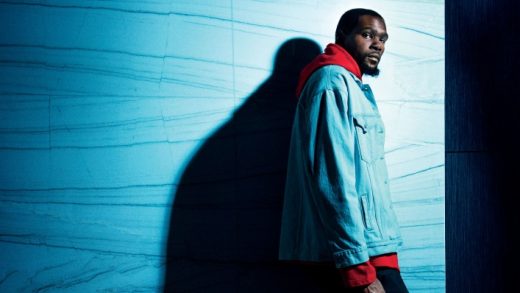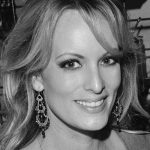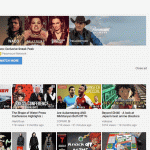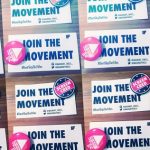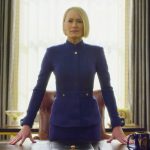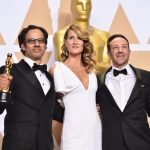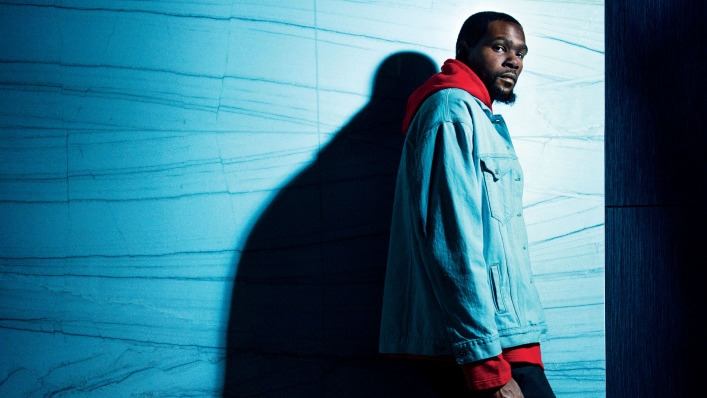Kevin Durant’s Killer Crossover
On a crystalline day this past summer, about eight weeks before the official start of the basketball season, Kevin Durant—the Golden State Warrior, reigning NBA Finals MVP, and (depending on your criteria) either the best or second-best pure player on Planet Earth—is standing on a makeshift court in the darkened corner of a YouTube soundstage in Los Angeles, bouncing a ball between his size 18 kicks. On television, Durant looks tall. In person, especially in the presence of regulation-size humans, he is alpine: 6 feet 9 inches of spindled limbs, elongated torso, and flashbulb-reflecting smile.
Today, he’s dressed in a style that might be described as High Grunge: faded concert T-shirt, billowy flannel, extremely expensive designer cargo pants. It’s not ideal on-court apparel, but it doesn’t seem to be holding him back. While the technicians on the set do their best not to gawk, he drives toward the hoop and, bending his frame around the side of the net, deposits the ball so precisely the fabric hardly whispers.
“My turn,” shouts his opponent, a towheaded middle schooler. “I just want to say, though, that I have to use both of my hands to shoot the ball.”
“That’s okay,” Durant laughs. “Sometimes I shoot with two hands, too.”
If the two-time Olympic gold medalist is sounding a little deferential to the 11-year-old now hurling an ungainly air ball in the general direction of the net, it’s because Durant knows this isn’t just any middle schooler. He’s Lincoln Markham, a YouTube personality who, together with his dad, Dan, cohosts a program called What’s Inside?, wherein the duo use an array of tools to slice open household objects, such as candy jawbreakers and Stretch Armstrong dolls. Durant is here to collaborate with them on videos that will go out across his fledgling YouTube channel and on the Markhams’ as a way to bring together their audiences and draw in new subscribers. Because if there’s one thing Lincoln excels at, it’s amassing views: Started as a second-grade science project, his channel currently has roughly 5 million subscribers who have watched its clips more than 665 million times.
Kevin Durant’s YouTube channel, by comparison, has 418,000 subscribers, and views on even the most popular content hover around 3 million. Granted, the channel, which features content created by Durant’s video company, Thirty Five Media, only launched in April. (The name refers to the age of Durant’s beloved childhood coach, Charles Craig, at the time of Craig’s murder.) And Durant is definitely still finding his voice: The collection currently consists of a handful of live streams shot around his summer rental home in Beverly Hills, footage from a recent trip to India, and a 35-minute Nike-made documentary, Still KD: Through the Noise, defending Durant’s surprise decision, in the summer of 2016, to leave the Oklahoma City Thunder for the Golden State Warriors.
So Durant has humbly come to this YouTube soundstage for what amounts to a lesson in the peculiar and more intimate bylaws of internet stardom: a live variety show with Lincoln and Dan and several other top YouTube creators, hosted by the web star Adande Thorne, known online as sWooZie. “The whole thing, it’s a good way for me to grow subscribers,” Durant tells me—subscribers being the currency of YouTube, and the path to both media-business credibility and potential millions in ad revenue.
The director for today’s segment wanders out onto the middle of the set. “Places, guys!” he hollers. “And remember—we’re here to have fun.”
For the next 40 minutes, while the cameras film, Durant trails sWooZie across the 4,500-square-foot soundstage, observing as Lincoln and Dan slice apart one of his Nike KDXs, and participating in a science experiment guided by an energetic 6-year-old named Ryan, whose Ryan ToysReview channel has roughly 9 million subscribers. Throughout, Durant wears a studious, attentive expression, even as he settles into a chair across from Sean Evans, of the show Hot Ones, whose shtick is interviewing celebrities while they gulp down chicken wings lathered with progressively spicier brands of sauce. The first two wings go down easy.
But by the fifth, as Durant gamely tries to answer a series of questions, his face is glowing with sweat. “That’s just, like, why would you make that,” he exclaims, finishing off a wing flavored with Da’ Bomb Beyond Insanity, a liquid rated at 27 times the heat of a jalapeño. “How many shows you do a week?” he demands of Evans. “Your stomach can’t be holding up.”
The clapper board slams shut. “That’s a wrap,” someone says. Durant lingers for a few minutes, signing autographs and posing for pictures with staff, before making his way to his SUV. In the backseat with the air conditioning blasting, he and his business partner and best friend, Rich Kleiman, fire up their phones to look at the results: more than 100,000 views of the segment, a number that would grow as the YouTubers uploaded versions to their own pages. (Less than a week after it was released, the Hot Ones clip reached 2 million views.) “It’s a hit, baby,” Kleiman hoots. Durant doesn’t immediately respond: He’s chugging from a 34-ounce bottle of Smartwater.
For him, the variety show is just the beginning. He and Kleiman have big plans for his YouTube channel: They see it growing into a hub for a variety of programming, with shows (some hosted by Durant and some not) devoted to entertainment, food, video games, and sports. Over time, they hope the platform will allow the basketball star to circumvent the traditional media tours a championship player is expected to go on—the late-night talk-show interviews, the sports-radio appearances. “This way, I talk directly to my fans,” Durant says. “If I have something to say, I’ll stream it to the page. It puts the power in my hands.” Eventually, scripted programming might follow, or a documentary series.
“Part of what’s impressed me,” says Neal Mohan, the chief product officer at YouTube, “is the intuitive grasp Kevin has on the technology.” Not only is Durant uploading new content at a fast clip, Mohan says, but he is spending a lot of time on the community tab, interacting with fans. “When you build that kind of connection, it can be an extremely powerful thing.”
And power is what Durant is looking for as he crafts an off-court—and eventually post-playing—career that confers the kind of respect and authority that he now earns through athleticism. For even as he was making the leap to the Warriors, Durant was also laying the foundation for a profound shift in his business dealings. Instead of just grabbing the low-hanging fruit of endorsement deals (which are particularly easy to grasp when you’re an NBA superstar with a 7-foot 5-inch wingspan), for the past year he’s been using his new perch in Silicon Valley to line up a different set of partners: angel investors, enterprise tech CEOs, drone makers, and app developers, along with pint-size YouTube creators.
Durant’s nascent business empire now includes Thirty Five Media and a hefty investment portfolio that he and Kleiman run under the auspices of the two-year-old Durant Company. That makes him part of a growing cohort of athletes who are looking to tech to expand their business holdings. It also signals a personal transformation for Durant, as he evolves from a fairly straightforward NBA star—one known as either the “nicest guy in the NBA” or a soft “cupcake,” in the parlance of scorned Oklahoma City fans—into a tenacious player-entrepreneur who is wielding his outsize salary and fame in surprising ways. And that means, for someone so accustomed to winning, learning to compete in entirely new realms.
Had you asked Durant a decade ago whether one day he’d be a budding entrepreneur—namechecked in TechCrunch and crowned “Silicon Valley’s hottest start-up” in the pages of The New York Times—he would have laughed.
“Truth is, I didn’t think about investing my money,” Durant says one afternoon this summer. “I just wanted to stack it. Like, put away enough for my grandkids and family. That was enough.” We’re sitting in the backyard of the home he’s renting in Beverly Hills, a glass-walled structure that looms over L.A., the spires of downtown poking like needles through a quilt of smog. Nearby, Kleiman and another buddy are playing a $1,000 game of Horse. “Ew!” Durant shouts as a brick shot rebounds into the wraparound pool. “Also, that’s my workout ball!” He collects himself, and goes on: “My focus was the court, you know?”
Durant’s career is the stuff of legend: The young and awkward prodigy, the son of a postal-worker mom from a poor part of Prince George’s County, on the outskirts of Washington, D.C., leaves home in 2006 for the University of Texas at Austin, and a year later is scooped up second overall in the 2007 draft. Nike signs him to a $60 million endorsement deal, with an extraordinary $10 million bonus; he’s promptly named NBA Rookie of the Year.
And yet the hype that suddenly surrounds him doesn’t intimidate him. It somehow, improbably, makes him better. It seems to drive him: to Olympic gold medals, to all-star games, to an appearance in the Finals with the Oklahoma City Thunder. Versatile, dynamic, and unflaggingly competitive, he regularly puts up 35 points a game. Soon, the kid whose single mother sometimes struggled to feed her family has an estimated net worth of approximately $200 million.
Durant’s interest in business began around 2013, the year he parted ways with his agent and signed with Kleiman at Jay-Z’s Roc Nation Sports. Durant and Kleiman came from radically different backgrounds: Kleiman, a native of Manhattan, got his start in the music industry, managing acts such as Mark Ronson. Just 35 when he and Durant started working together, Kleiman was voluble and gleefully profane—an Ari Emanuel on the make. Durant liked him immediately, and he paid attention when Kleiman advised him to be more proactive with his wealth.
“I started to read, to really read, about all these successful men who hadn’t played basketball,” Durant remembers. He devoured books on Jeff Bezos and Steve Jobs—”I went all the way back to [Nikola] Tesla and [Cornelius] Vanderbilt,” the turn-of-the-century shipping magnate. The men were ambitious, and they pushed the boundaries of what their peers thought was possible.
Perhaps it’s not surprising that his first investments with Kleiman were in tech rather than real estate, or a traditional realm like car washes or dealerships. It all started in 2014 when Kleiman was in New York and got a craving for Mr. Chow, the Midtown Manhattan Chinese eatery. But the restaurant refused to deliver; nor would it accept Kleiman’s offer to send over an Uber. Instead it suggested he download Postmates. The app would locate a bike courier to get the food and bring it to his apartment.
Kleiman told Durant, who was intrigued. On Durant’s next trip to the Bay Area, he and Kleiman happened to drive by the Postmates offices; Durant suggested they cold-call the founder. They scheduled a meeting, and not long after, Durant committed an investment in the high six figures to a 2015 $80 million series D funding round, joining the likes of Tiger Global Management and noted VC firms Slow Ventures and Spark Capital. That was followed by funding for the micro-investing app Acorns and The Players’ Tribune, Derek Jeter’s publishing platform for athletes.
“With a lot of celebrity investors, the extent of our interactions is, ‘Hey, do you want to come to this movie premiere?’?” Postmates CEO Bastian Lehmann tells me. “And that’s fun, but Kevin wants more: He wants to understand the business; he’s got ideas.” Lehmann says he scrapped plans to redesign the logo after discussing it over dinner with Durant.
When Durant announced he was signing with the Warriors in July of last year, everyone seized on the idea that he wanted the most direct path to a championship ring. The superstar team had narrowly lost in the 2016 Finals and was widely expected to make the championship again. As Durant wrote on The Players’ Tribune, the Warriors represented “the greatest potential for my contribution and personal growth.” Yet there was no denying the team’s proximity to the tech world. “That’s not why you’d make the decision,” Kleiman says, “but it is an incredible bonus.”
In September of last year, the legendary investor and philanthropist Ron Conway traveled to Atherton, California, for a party at the home of his friends Ben and Felicia Horowitz. A cofounder of the venture-capital firm Andreessen Horowitz, Ben is a Warriors season-ticket holder and die-hard fan—the occasion for the party was Durant’s 28th birthday. Durant and the other players were late showing up, and Conway—famously an early backer of Google and PayPal—soon found himself locked in conversation with a bald, green-eyed man in his late thirties. “He was literally the only other person I had to talk to,” Conway recalls of Kleiman.
When Kleiman mentioned that he represented Durant, and that Durant was eager to expand his portfolio of investments, Conway suggested that the three of them get together for dinner. A few weeks later, they were sitting around a table in Conway’s living room. For more than two hours, the trio discussed the VC world and Durant’s charity, which helps build basketball courts for disadvantaged children around the world. “I could tell he truly wanted to give back,” Conway says. He agreed to help advise Durant on other philanthropic projects, later connecting him with College Track, a nonprofit cofounded by Laurene Powell Jobs. Through the college-preparatory program, Jobs will be Durant’s partner on a massive new youth center to be built later this year in D.C.
Conway also offered to share with Durant a list of his recent investments. “I was blown away,” he says, “because [Durant] knew about half the companies without me identifying them. He knew the names, he knew what they did.” Durant has since invested in several of the startups on Conway’s list, including the bot-based polling company Polly.
Durant isn’t short on resources in the Bay Area: Along with Conway, Durant speaks regularly to Ben Horowitz, and he plays cards with Chamath Palihapitiya, a co-owner of the Warriors who leads the multibillion-dollar VC firm Social Capital. And he relies on the counsel of two other Warriors: Stephen Curry, who cofounded Slyce, a publishing app for athletes, and Andre Iguodala, who created the annual Players Technology Summit. “They know exactly what to do with their money,” Durant says, “and we bounce ideas off each other.”
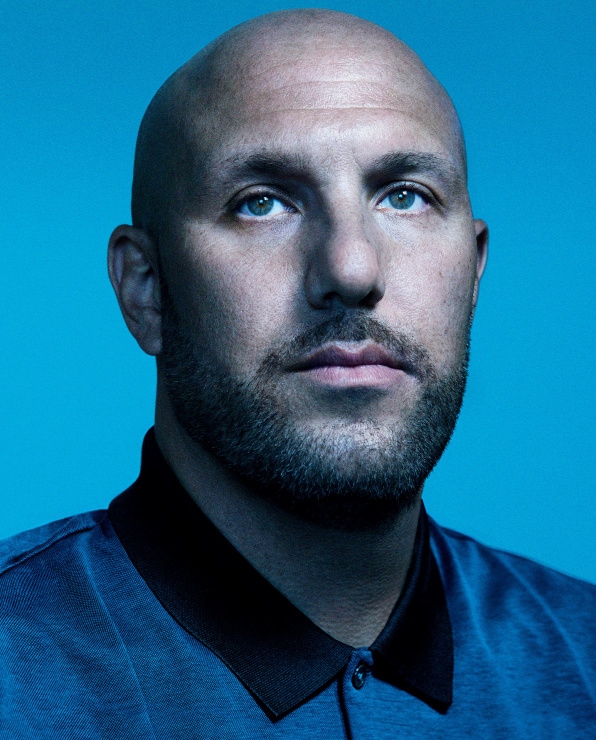
He has also benefited from the examples of other NBA stars. Carmelo Anthony and Kobe Bryant have both launched venture-capital firms to power their tech investments; LeBron James has inked content deals with major networks, such as HBO. “In the past, unfortunately, some athletes never gave much thought to what would happen when their careers ended,” says Carl Chang, the CEO of a private-equity fund and brother of former tennis pro Michael Chang. “Today, they’ve become much more sophisticated in terms of foresight and preparations.”
Durant has developed his own internal formula for determining his investments. “As a kid, he was always watching who was coming up behind him,” says Kleiman, who started working with Durant full time two years ago, “and he looks for that now in creators: He wants them to be as paranoid as he was.” Not long ago, Durant asked the founders of an autonomous drone startup, Skydio, to give him a demo at his place in Oakland. Durant reached over to touch the drone, and one of the founders “jumped 10 feet in the air,” Kleiman recalls. “And Kevin loved that: that proprietary instinct.” (Adam Bry, the CEO of Skydio, reports that Durant “got the technology right away. In fact, I’d argue that he probably understood it better than a lot of other professional tech people.”) Durant has since signed on as an investor.
He’s also guided by an instinct for long-term bets. “Kevin is such an inquisitive, cerebral person,” says Social Capital’s Palihapitiya. “He makes sure he understands exactly how things work—what resonates and what doesn’t.” To Palihapitiya, the decision to partner with YouTube, over platforms such as Snapchat or Twitter, was proof: “YouTube has a much larger global reach. It gives him more of an opportunity to grow his brand.”
Over breakfast one morning at the Beverly Hills Hotel, where he stays while in L.A., Kleiman opens up his iPhone to a note file outlining Durant’s investments. There are some 30 in all, ranging in scale from $50,000 to $2 million. Not all involve tech: Durant has taken a stake in a watermelon water company; the upscale Manhattan restaurant the Grill; and in Pieology, a chain of pizza joints headed by Carl Chang. “It’s an incredibly promising start,” Kleiman says, and mentions that he and Durant have been batting around the idea of putting together their own VC firm.
Of course, tech investing is a notoriously tricky game: Even the wiliest, most seasoned VCs lose money on their investments. “With venture capital,” says David Abrutyn, a partner at Bruin Sports Capital, an investment firm, “you’ve got to go in with an open mind. You’ve got to understand that if you make 10 investments, two might hit.” Durant, who dominates the court in almost every game he plays, hasn’t had much experience with that kind of loss ratio.
“It’s a risk,” Durant allows. “But it’s a calculated risk.”
As I drive through Hollywood with Durant and Kleiman one afternoon, the news breaks of a blockbuster deal that will send Cleveland Cavaliers star Kyrie Irving to the Celtics, in exchange for a 2018 draft pick and Isaiah Thomas, a player beloved by Boston fans for leading his team, improbably, to the 2017 Conference Finals. Neither Durant nor Kleiman had an inkling the transaction was in the works, and for a few minutes, they converse, in growing tones of incredulity, about what it means for the balance of power in the NBA.
Finally, Kleiman turns in my direction. As a Boston fan, am I upset? I have no right to be, he goes on, adding an expletive for emphasis. “It’s a business, you know?”
Durant, who has joked that he’s been branded a snake so many times since leaving the Thunder that he “might just tattoo one of those things on my arms,” quickly agrees: “Ain’t no loyalty in this shit,” he says.
This was the Kevin Durant I see on multiple occasions during our time together: a student of business realities and a player unsentimental about his sport and his place in it. A player, in other words, willing to clap back at his former Oklahoma City fans by releasing, in September, a limited edition of his Nike KDX, their insoles emblazoned with insults that have been hurled his way (“follower,” “soft,” “snake”). Scrawled on top are his stats from the 2017 Finals and the words “Finals Most Valuable Player.”
A half hour later, we arrive back at Durant’s rental. The house is thrumming with activity: In the kitchen, Durant’s personal chef is preparing dinner, and in the living room, his stylist is arranging potential outfits for an upcoming photo shoot. Durant pulls out a black hoodie and nods appreciatively. Kleiman’s phone rings: It’s Durant’s nutritionist, calling to review a list of suggested vitamin supplements.
“What time is training?” Durant asks.
“You’ve got a few minutes,” Kleiman says, checking his watch.
It is difficult to overstate the importance of the upcoming basketball season for Durant. As Erik Malinowski, the author of Betaball, a new book about the Warriors, puts it, if 2016–17 was about Durant “evolving as a player and a teammate,” the upcoming season will be about carrying forward a legacy, and proving that he deserves the fame that has followed him for the better part of a decade. The pressure will be intense.
At the same time, Durant’s business commitments are ratcheting up. A few days after I leave L.A., he is slated to travel to Las Vegas to appear at a tech conference with the founders of Rubrik, a cloud-based data-management platform that he recently invested in. He is also planning a few meetings with the marketing team at Alaska Airlines, which has tapped Durant to help build out its presence at its big new San Francisco hub, gained through its Virgin America acquisition. Durant is taking equity in the company, and Alaska will partner with Thirty Five Media on content for his YouTube channel.
Durant is well aware that in 2017, he is by no means the only basketball player with a side hustle, what with Anthony, Bryant, and James tending to their tech and media fiefdoms. But he bristles at comparisons.
“Come on, they’re all competitive. That’s their job!” Kleiman exclaims when I ask about it. He is competitive, too: “Sometimes I’ll be like, ‘Yo, Kobe just did this,’ or ‘Carmelo got in on that.’ Or I’ll hear that Maverick Carter”—LeBron’s business partner—”had dinner with X, and I’ll go, ‘Shit, that means I’ve got to go have dinner with those motherfuckers too.’?”
Durant stands up: He wants to go downstairs and try on some clothes for the shoot. “I’d call it a healthy competition,” he says before descending. He smiles, then adds, “It’s not malicious.”
Fast Company , Read Full Story
(105)

